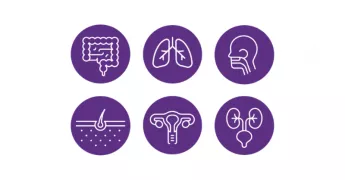United States 2024: knowledge and behaviors about microbiota
The survey was conducted by Ipsos among 7,500 people
in 11 countries (United States, France, Spain, Portugal, Poland, Finland, Brazil, Mexico, Morocco, China, and Vietnam).
State of the microbiota in the United States: progress to be continued in microbiota knowledge, Americans must now change their behavior to preserve their microbiota.
1. In the United States, knowledge of microbiota is on the rise this year

26% know exactly what a microbiota is (+4 points vs. 2023, 23% overall).
Microbiota diversity is also better known this year: 21% know about the vaginal microbiota (+2 points vs. 2023, 20% overall), 21% know the oral microbiota (+3 points vs. 2023, 20% overall) and 22% know the skin microbiota (+4 points vs. 2023, 17% overall).
Americans' knowledge of the characteristics of the microbiota remains below that of the other countries surveyed
know that the microbiota is not located exclusively in the intestines (-2 points vs. 2023, 46% overall)
know that the microbiota enables the intestine to deliver essential health information to the brain (+3 points vs. 2023, 53% overall).

Microorganisms: key for human health
Find out more...
2. Americans are less likely to have adopted behaviors to keep their microbiota balanced
Americans are less likely to have adopted behaviors that favor the balance of their microbiota (54% vs. 58% overall).
adopt a varied and balanced diet
(vs 84% overall).
limit the consumption of processed foods
(vs 75% overall).
avoid washing more than once a day
(vs 41% overall).

Diet
Find out more...Some behaviors, however, are more common in the USA, notably the consumption of probiotics (54% vs. 50% overall).
3. This year, Americans have received more information about microbiota from their healthcare professionals
Healthcare professionalsare considered by almost 4 out of 5 Americans (77% vs. 78% overall) to be the most reliable source of information.
However, a significant proportion of the population still hasn't received any information.
have been informed by their healthcare professional about what the microbiota is and what it is used for (+15 points vs. 2023, 45% overall).
have received explanations about the right behaviors to maintain a balanced microbiota (+14 points vs. 2023, 48% overall).
have been made aware of the importance of preserving the balance of the microbiota (+14 points vs. 2023, 48% overall).
Even when antibiotics are prescribed, the level of information transmitted is low, and remains below that of other countries, despite some progress.
34% of Americans have been made aware of the negative consequences of taking antibiotics on the balance of their microbiota (+9 points vs. 2023, 39% overall).

Have you heard of "dysbiosis"?
Find out more...In summary
Progress has been made in the USA this year in terms of knowledge of the microbiota and information passed on by healthcare professionals, but greater awareness on the part of healthcare professionals is essential to improve their understanding and, above all, their behavior.

Methodology
This second edition of the International Microbiota Observatory was conducted by Ipsos on 7,500 individuals across 11 countries (France, Spain, Portugal, Poland, Finland, Morocco, the USA, Brazil, Mexico, China, and Vietnam). Four new countries were included in this second edition: Poland, Finland, Morocco, and Vietnam.
The survey was conducted over the Internet between January 26 and February 26, 2024. For each country, the sample is representative of the population aged 18 and over in terms of :
- gender
- age
- profession
- region
Representativeness was ensured via quota sampling, the most commonly used sampling method for obtaining a representative sample of the population studied. The quota variables for each country were gender, age, region, and socio-professional category. The data were adjusted:
- within each country, again to ensure that each population is representative
- globally, so that each country has the same weight. Statistical analyses were carried out using Cosi software (M.L.I., France, 1994), with a significance level of 95%
The survey population was 48% male and 52% female. The average age was 46.1 years. The sample of 7,500 individuals made it possible to carry out a detailed analysis by age group:
- 18-24
- 25-34
- 35-44
- 45-59
- 60 and over
Changes from one year to the next have been measured on a like-for-like basis, i.e. calculated taking into account only those countries present in both the first and second editions of the survey. While we do have results for the new countries included in this second edition (Poland, Finland, Morocco, and Vietnam), they have not been taken into account when calculating trends, since they were not included in the first edition of the survey.
The questionnaire includes 27 questions on:
- socio-demographic data
- the level of knowledge about microbiomes
- the level of and desire for information from healthcare professionals
- the identification and adoption of behaviors designed to combat microbiome imbalances
- the level of knowledge, information, and behaviors of women about the vulvo-vaginal microbiome
- health data
The questionnaire lasted ten minutes and the 7,500 individuals had to complete the entire questionnaire in order to be included in the survey. The terms used in the questionnaire to talk about the microbiome have been translated and adapted to the terms used in each country.


